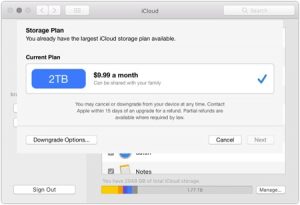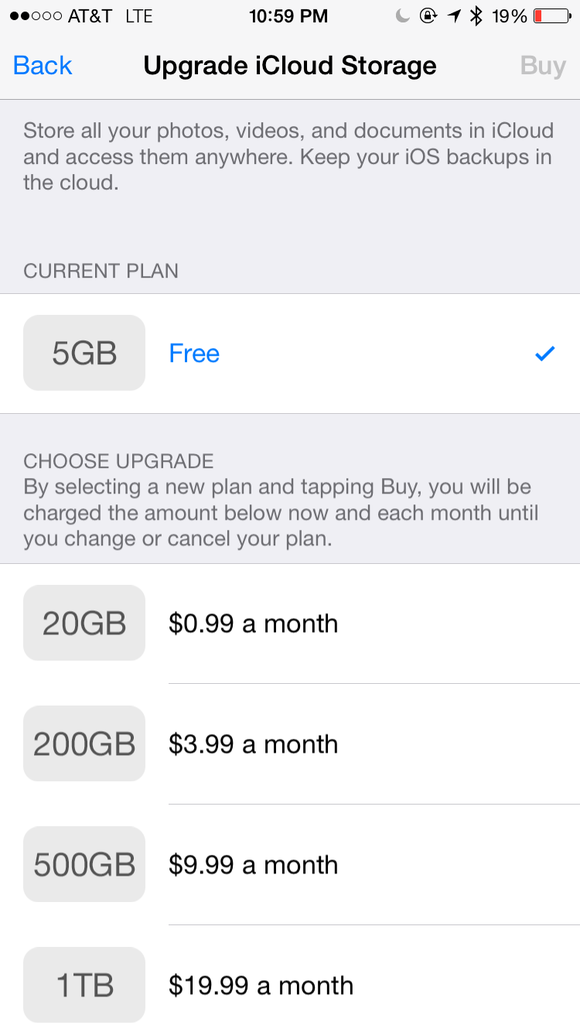
In iOS 5, Find My iPhone was continued as a feature for iCloud. An iOS app was also released by Apple on June 18, 2010, which allows users to locate their device from other iOS devices running iOS 4 or later software.
#ICLOUD PRICING UPDATE#
Find My iPhone was made free of charge with the iOS 4.2.1 software update on November 22, 2010, but only for devices introduced in 2010. The feature was first announced on June 10, 2009, and was included in the iOS 3.0 software update as a feature for paying MobileMe users.
#ICLOUD PRICING PASSWORD#
A user can see the device's approximate location on a map (along with a circle showing the radius depicting the margin of error), display a message and/or play a sound on the device (even if it is set to silent), change the password on the device, and remotely erase its contents. In case of a malfunction of any Apple device, during the restoration process, iCloud offers to restore all data along with App data only if the device was synced to iCloud and backed up.įind My iPhone, formerly part of MobileMe, allows users to track the location of their iOS device or Mac.

Backups occur daily when the device is locked and connected to Wi-Fi and a power source. Data backed up includes photos and videos in the Camera Roll, device settings, app data, messages (iMessage, SMS, and MMS), ringtones, and Visual Voicemails. ICloud allows users to back up the settings and data on iOS devices running iOS 5 or later. Third-party iOS and macOS app developers can implement iCloud functionality in their apps through the iCloud API. Siri (settings, and past interactions with Siri and Dictation).Safari (syncing bookmarks and history).Apple Wallet (passes and credit cards).Apple Music (with a feature called iCloud Music Library).Apple Home (settings and paired devices).Apple Books (books, highlights, bookmarks and annotations).ICloud is also built-in as a backend to many Apple apps and system features, where it can sync users' data and settings. Find My, which lets users find their Apple devices or other Find My-enabled devices, and remotely erase lost Apple devices.Notes and Reminders sync, and the ability to edit and create notes and reminders on the web.Pages, Keynote, and Numbers, allowing real-time collaboration on both native apps and the web.iCloud Photos, which stores and syncs pictures in full-resolution.iCloud Drive, a cloud storage and syncing feature.Contacts and calendar syncing, and calendar sharing features, as well as support for CardDAV and CalDAV.iCloud Mail, a free email address which supports Push email, a webmail interface, and IMAP sync to third-party clients.

Some of iCloud's features are accessible not only through apps built-into macOS, iOS and iPadOS, but also on. Users can subscribe to iCloud+ for additional storage up to 2 TB. ICloud is a free service, and come with 5 GB of cloud storage. In March 2022, Apple settled a class-action lawsuit alleging that it had misled users by storing data on non-Apple servers. In June 2021, Apple introduced iCloud+, which added Private Relay, Hide My Email and custom email domains to paid users of the services, as well as an unlimited storage limit for video from cameras added through HomeKit Secure Video.
#ICLOUD PRICING WINDOWS 10#
In June 2019, iCloud was introduced to Windows 10 via the Microsoft Store. Apple also operates the own data centers, including one in Maiden, North Carolina. In 2021, The Information reported that Apple was storing 8 million TB of data on Google's cloud, and was on track to spend $300 million that year. In 2016, Apple replaced Azure with Google Cloud Platform. Since its launch, iCloud was partly hosted on Amazon Web Services and Microsoft Azure. These issues were addressed in iOS 7 and OS X Mavericks. It received early criticism for bugs, especially with Core Data syncing.

ICloud had 20 million users in less than a week after launch. Previous MobileMe users could keep their and email addresses as aliases to their new address. iCloud was released on October 12, 2011, and MobileMe was discontinued on June 30, 2012. On June 6, 2011, during the WWDC 2011 keynote, Steve Jobs announced that iCloud would replace MobileMe, which had been widely seen as a "failure", a fact which Steve Jobs acknowledged during the announcement. ICloud was announced on in a press release.


 0 kommentar(er)
0 kommentar(er)
